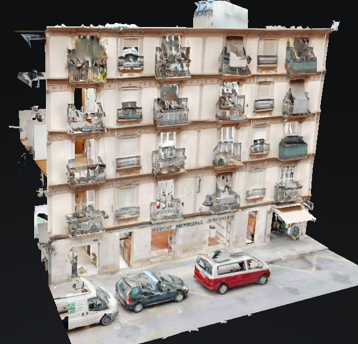Although the least digitized sector, digitalization in the construction sector is growing steadily thanks to the push from the industry and policymakers. The INPERSO project aims to foster the uptake of the application of scanning technologies and Building Information Modelling (BIM) throughout the entire Design and Constriction (D&C) process. This article presents the R2M’s semi-automatic Scan-to-BIM concept tool implemented in INPERSO.
The construction sector has a crucial role in the economy, contributing to over 9% of the European GDP. However, it is one of the least digitized sectors in the EU. The level of maturity and the application of digital solutions is uneven in Europe among member states, different technologies and also different phases of the construction process. Nevertheless, it is growing steadily thanks to the push from industry and policymakers. For example, research has shown that among data acquisition technologies, 3D scanning is being increasingly used as well as drones.
In contrast, regarding digital information, Building Information Modelling (BIM) is more and more used in AEC sector (Architecture, Engineering, Construction) mainly thanks to the policymakers that have put in place BIM requirements in public procurement processes. However, BIM is still mainly used during the design phase of large and complex projects, and less during construction management, while its market adoption remains moderate. In 2020, only 29% of construction companies used BIM while 61% had never used it. However, BIM has great potential for the renovation, refurbishment, and maintenance of the built environment.
The numerous possibilities using 3D scanning
3D scanning is the process of creating a 3D model of a building by scanning it from all possible angles. This is an automatic technique for the acquisition of spatial data. Examples include photogrammetry and laser scanning. Digital photogrammetry works by capturing images and turning these images into 3D point clouds. Laser scanners use multiple points of amplified light to measure distances from the scanner to its target. Laser scanning enables the measurement of millions of spatial points per second, creating a point cloud that can be used to generate the BIM. Photogrammetry allows taking digital photos of the building and, through specific software, obtaining reliable information to generate the BIM.
BIM as a strategic enabler

BIM is the holistic process of creating and managing information for a built asset. It integrates structured and multi-disciplinary data to produce a digital representation of an asset across its lifecycle. BIM is a strategic enabler, improving decision making for both buildings and public infrastructure assets across their entire lifecycle. It still applies mainly to new constructions; however, more and more BIM supports the renovation, refurbishment and maintenance of the built environment – the largest share of the sector.
How INPERSO and contributes to the digitalization of the construction industry
The INPERSO project aims to foster the uptake of the application of scanning technologies and BIM throughout the entire Design and Constriction (D&C) process. Photogrammetry is used as a 3D scanning technology for the spatial data acquisition of the two Demo Cases: a multifamily building in Valencia (Spain) and a heritage monastery complex in Velp (The Netherlands). From the point cloud generated from the 3D scanning, the BIM models are built and can be used by the pilots and technology providers for the design of the renovation processes.
How INPERSO and contributes to the digitalization of the construction industry
In INPERSO, a step forward is taken in the combination of different technologies to speed up data collection and modelling processes. In fact, R2M is developing a semi-automatic Scan-To-BIM concept tool as part of the SCAAI task. SCAAI stands for Scan-to-BIM with AI capabilities. It allows the fast assembly of a preliminary BIM model based on a scanned 3D point cloud. This Scan-To-BIM approach consists of
- a methodology for scanning the building by using the latest scanning technologies and creating the BIM model;
- a web platform that makes use of innovative technologies (AI, Machine learning and Computer Vision) to process an input point cloud obtained from a 3D scan and automatic generation of BIM files, which can later be enriched by manual input. These BIM files can be downloaded or automatically uploaded to the INPERSO Platform.
If you are interested in Scan-to-BIM solutions for your building, check more here.

























